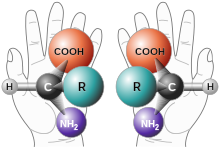Racemization
In
Stereochemistry

Chiral molecules have two forms (at each point of asymmetry), which differ in their optical characteristics: The levorotatory form (the (−)-form) will rotate counter-clockwise on the plane of polarization of a beam of light, whereas the dextrorotatory form (the (+)-form) will rotate clockwise on the plane of polarization of a beam of light.[1] The two forms, which are non-superposable when rotated in 3-dimensional space, are said to be enantiomers. The notation is not to be confused with D and L naming of molecules which refers to the similarity in structure to D-glyceraldehyde and L-glyceraldehyde. Also, (R)- and (S)- refer to the chemical structure of the molecule based on Cahn–Ingold–Prelog priority rules of naming rather than rotation of light. R/S notation is the primary notation used for +/- now because D and L notation are used primarily for sugars and amino acids.[2]
Racemization occurs when one pure form of an enantiomer is converted into equal proportion of both enantiomers, forming a
Partial to complete racemization of stereochemistry in solutions are a result of SN1 mechanisms. However, when complete inversion of stereochemistry configuration occurs in a substitution reaction, an SN2 reaction is responsible.[3]
Physical properties
In the solid state, racemic mixtures may have different physical properties from either of the pure enantiomers because of the differential intermolecular interactions (see Biological Significance section). The change from a pure enantiomer to a racemate can change its density, melting point, solubility, heat of fusion, refractive index, and its various spectra. Crystallization of a racemate can result in separate (+) and (−) forms, or a single racemic compound. However, in liquid and gaseous states, racemic mixtures will behave with physical properties that are identical, or near identical, to their pure enantiomers.[4]
Biological significance
In general, most
The stereoselective nature of most biochemical reactions meant that different enantiomers of a chemical may have different properties and effects on a person. Many psychotropic drugs show differing activity or efficacy between isomers, e.g.
Racemization of
Another commonly used drug is ibuprofen which is only anti-inflammatory as one enantiomer while the other is biologically inert. Likewise, the (S) stereoisomer is much more reactive than the (R) enantiomer in citalopram (Celexa), an antidepressant which inhibits serotonin reuptake, is active.[11][5][12] The configurational stability of a drug is therefore an area of interest in pharmaceutical research.[13] The production and analysis of enantiomers in the pharmaceutical industry is studied in the field of chiral organic synthesis.
Formation of racemic mixtures
Racemization can be achieved by simply mixing equal quantities of two pure enantiomers. Racemization can also occur in a chemical interconversion. For example, when (R)-3-phenyl-2-butanone is dissolved in aqueous ethanol that contains
Racemization can occur through some of the following processes:
- Substitution reactions that proceed through a free carbocation intermediate, such as unimolecular substitution reactions, lead to non-stereospecific addition of substituents which results in racemization.
- Although unimolecular elimination reactions also proceed through a carbocation, they do not result in a chiral center. They result instead in a set of geometric isomers in which trans/cis (E/Z) forms are produced, rather than racemates.
- In a unimolecular aliphatic electrophilic substitution reaction, if the carbanion is planar or if it cannot maintain a pyramidal structure, then racemization should occur, though not always.[15]: 517–518
- In a free radical substitution reaction, if the formation of the free radical takes place at a chiral carbon, then racemization is almost always observed.[15]: 610
The rate of racemization (from L-forms to a mixture of L-forms and D-forms) has been used as a way of dating biological samples in tissues with slow rates of turnover, forensic samples, and fossils in geological deposits. This technique is known as amino acid dating.
Discovery of optical activity
In 1843, Louis Pasteur discovered optical activity in paratartaric, or racemic, acid found in grape wine. He was able to separate two enantiomer crystals that rotated polarized light in opposite directions.[11]
See also
- Dextrorotation and levorotation
- Enantiomer
- Racemic mixture
References
- ^ a b Kennepohl D, Farmer S (2019-02-13). "6.7: Optical Activity and Racemic Mixtures". Chemistry LibreTexts. Retrieved 2022-11-16.
- PMID 21291399.
- ISBN 978-1-337-51640-2.
- PMID 10942967.
- ^ ISBN 978-0-470-54784-7.
- PMID 4564954.
- S2CID 37728304.
- ^ Stolberg SG (17 July 1998). "Thalidomide Approved to Treat Leprosy, With Other Uses Seen". The New York Times. Retrieved 8 January 2012.
- ^ "Use of thalidomide in leprosy". WHO:leprosy elimination. World Health Organization. Archived from the original on November 10, 2006. Retrieved 22 April 2010.
- PMID 17168659.
- ^ ISBN 978-1-4292-3414-6.
- PMID 17675913.
- ISBN 978-3-642-62575-6.
- ISBN 978-0-02-946720-6.
- ^ ISBN 978-0-471-85472-2.
